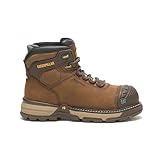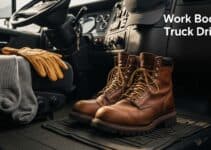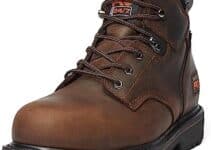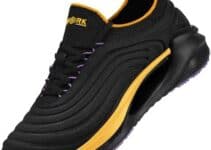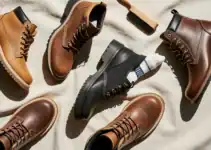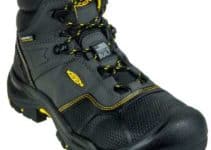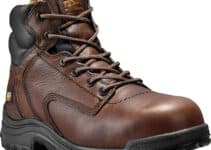You’re climbing down from the cab of your D9, and a heavy D-shackle slips from your hand. It misses your steel toe… and lands squarely on the top of your foot, shattering the small, delicate bones with thousands of pounds of force. This is a career-ending injury.
Here’s the honest truth: A standard steel toe boot is only half the protection you need. The steel toe only protects your toes, stopping right at the flex point. For heavy equipment operators, the primary risk is crushing impact behind the toe cap from dropped tools, parts, chains, or getting a foot pinned by equipment.
As boot experts who’ve spent decades on-site, we’re here to tell you: a standard safety boot is incomplete for your job. You need a Metatarsal Guard Boot. This guide cuts through the confusion, explains the different types of “met guards,” why they’re critical for operators, and reviews the top 5 boots that deliver maximum protection without feeling like a medieval suit of armor.








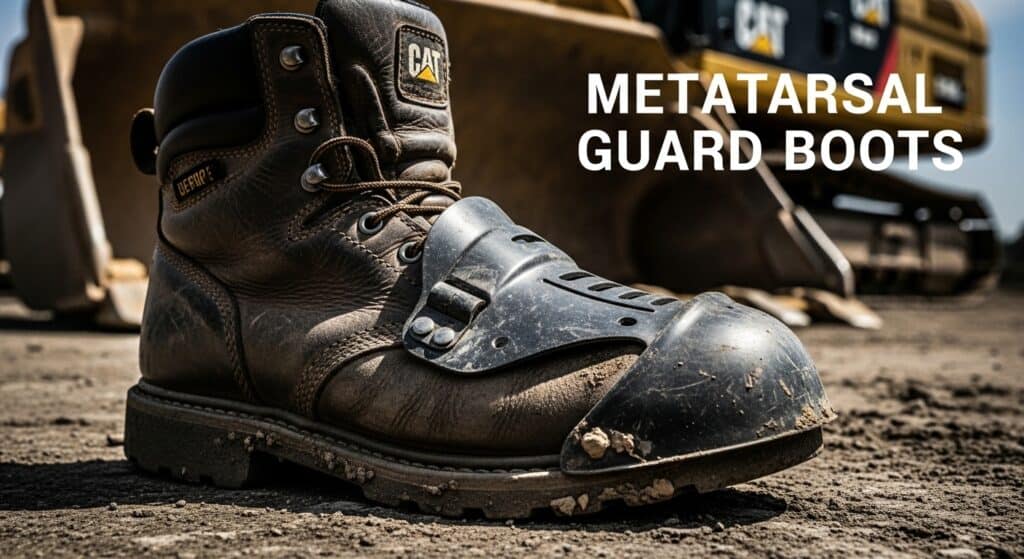
best metatarsal guard boots
Quick Picks Table: Top 5 Met Guard Boots for Operators (2026)
Here are our top picks, ranging in price to help you find the right protection for your job and budget.
| Award | Boot Model | Met Guard Type | Best For | Safety Toe? | Price |
|---|---|---|---|---|---|
| 🏆 Best Overall | Timberland PRO Endurance 6″ Met Guard | External (Hinged) | All-Around Durability & Protection | Steel | $$$ |
| ☁️ Best Lightweight & Flexible | Cat Excavator Superlite WP | Internal (D3O®) | Agility, Driving & Modern Comfort | Comp (Nano) | $$$ |
| 💪 Best Premium/Durable | Danner Quarry USA 8″ Met Guard | Internal (D3O®) | Extreme Durability & Waterproofing | Alloy (NMT) | $$$$$ |
| 🥾 Best Logger (Uneven Terrain) | Carolina Logger 8″ Met Guard | External (Hinged) | Maximum Traction & Ankle Support | Steel | $$$ |
| ⚙️ Best Pull-On Convenience | Ariat WorkHog XT Met Guard | Internal (XRD®) | Easy On/Off & Ranch/Farm Ops | Comp Toe | $$$ |
The “Met Guard Bible”: An Operator’s Guide to Full Foot Armor
What is a Metatarsal Guard (And Why Do Operators Need One)?
Metatarsal work boots are specialized footwear built with metatarsal guards (met guards) that provide extended coverage over a larger area of the foot. These guards shield the metatarsals—the long, delicate bones on the top of your foot that connect your toes to your ankle area.
The metatarsal bones are vulnerable because they stick out past the body line and sit beneath only a thin layer of skin, making them prone to severe fracture if impacted by a heavy object. Metatarsal fractures are common, extremely painful, and can take months or even years to fully heal.
This is why regulatory bodies demand specific protection:
- The Key Rating: The federal standard in the U.S. requires safety footwear to comply with ASTM F2413. For met guards, you must look for the MT/75 rating.
- MT/75 Explained: This rating certifies that the metatarsal guard can withstand a crushing impact of 75 foot-pounds (e.g., a 75-pound weight dropped from one foot) without failing.
Think of it this way: A steel toe is a helmet for your toes; a met guard is the chest protector for your foot.
The Critical Choice: External vs. Internal Met Guards
Met guards are fitted either outside the boot or incorporated inside. Choosing the right style depends on balancing protection with mobility.
External guards (left) offer max deflection, while internal guards (right, shown in cutaway) offer flexibility.
| Feature | External Met Guards (Hinged shield on top) | Internal Met Guards (Shield under the leather) |
|---|---|---|
| Pros | Maximum impact deflection. Protects laces. Deflects sparks/molten metal (great for welders). Superior against slower compression. | Streamlined (no snag hazard). More flexible and comfortable for walking, kneeling, and driving. |
| Cons | Bulky, heavier, and stiffer. Can snag on grating or equipment. | Covers a slightly smaller area. Less protection against sparks. Can sometimes be felt inside the boot. |
The “Smart Foam” Advantage: New internal met guards use “smart foam” materials like D3O® or XRD®. These foams are soft and flexible for walking and driving, but the molecules instantly lock together and become rigid upon impact to absorb the force. This provides the best of modern comfort and protection.
What Else Operators Need (The Non-Negotiables)
For heavy equipment operators, core features beyond the met guard are critical for safety and performance.
| Feature | Why It Matters for Operators |
|---|---|
| Defined 90-Degree Heel | This is non-negotiable for safe climbing. A wedge sole is a slip hazard on equipment. You need a 90-degree heel to safely hook ladder rungs and equipment tracks. |
| Aggressive, Oil-Resistant Traction | Your sole constantly encounters gravel, mud, grease, and slick metal. Look for deep, self-cleaning lugs made from rubber compounds rated for oil and slip resistance (SR/SRC). |
| Full Waterproofing | Construction sites are frequently wet. A full waterproof membrane (like Gore-Tex® or a proprietary equivalent) is essential for keeping your feet dry and comfortable through long shifts. |
| Durable Construction | These boots take a beating. Look for a Goodyear Welt (resolable) or a heavy-duty Direct Attach construction. Simple cemented (glued) soles won’t last. |
| Molded Toe Bumper | A rubber cap over the toe leather protects the boot’s highest wear-point from abrasion when kicking controls, climbing, or kneeling. |
Top 5 Met Guard Boots for Operators: Detailed Reviews
🏆 1. Best Overall: Timberland PRO Endurance 6″ External Met Guard
The Honest Take: This boot is a reliable tank, built on a steel toe platform with a rugged, heat-resistant (HRO) sole. The external met guard is hinged, meaning it flexes better than older rigid flaps while still offering maximum impact deflection. It features Timberland’s Anti-Fatigue technology for comfort on hard surfaces. Be prepared for a moderate 1–2 week break-in period due to its stiff, highly protective build, but it’s a no-nonsense boot for serious protection.
Pros & Cons
| Pros | Cons |
|
|
Best For: All-around heavy-duty use, welding, demolition, scrap yards.
☁️ 2. Best Lightweight & Flexible: Cat Excavator Superlite WP
The Honest Take: If you hate feeling like you’re wearing concrete blocks, this is your boot. The protection comes from an internal D3O® met guard, which remains soft and flexible until a sudden impact. It features a light Nano-composite safety toe and is fully waterproof. It’s comfortable right out of the box, feeling more like a light hiker. This internal guard is the best choice for operators prioritizing agility and driving comfort. The trade-off for lightness is that it is cemented (not resolable).
Pros & Cons
| Pros | Cons |
|
|
Best For: Operators prioritizing agility, driving comfort, and modern, lightweight feel.
💪 3. Best Premium/Durable: Danner Quarry USA 8″ Met Guard
The Honest Take: The Danner Quarry is an investment in your feet. It is made in the USA with Danner’s legendary stitchdown construction (fully resolable/rebuildable) and is built to last for years. This model integrates an internal D3O® met guard and a Gore-Tex liner for 100% waterproof protection. The 8-inch height provides excellent ankle support, and the Vibram® Quarry sole is top-tier. It requires a solid 1–2 week break-in period, but the leather and cork footbed will mold to your foot for a true custom fit.
Pros & Cons
| Pros | Cons |
|
|
Best For: Serious professionals, extreme durability, all-weather protection, and a resolable investment.
🥾 4. Best Logger (Uneven Terrain): Carolina Logger 8″ Met Guard
The Honest Take: For operators working on extreme slopes, in deep mud, or on logging sites, a standard work boot won’t cut it. This Carolina Logger provides a tall 8-inch shaft for ankle support and a deep-lug logger heel for aggressive traction and climbing. The external steel met guard and steel safety toe offer maximum, uncompromising protection. This is a stiff, heavy-duty logger; expect a significant break-in period to soften the thick leather. It’s a specific tool for the most rugged jobs.
Pros & Cons
| Pros | Cons |
|
|
Best For: Logging operators, steep grades, extreme-traction environments where foot support is paramount.
⚙️ 5. Best Pull-On Convenience: Ariat WorkHog XT Met Guard
The Honest Take: Climbing in and out of a cab all day? Laces are a pain. The Ariat WorkHog XT gives you pull-on speed with an internal XRD® met guard. XRD is another “smart foam” that stays soft and flexible until it’s hit, then instantly hardens. This boot is waterproof, has a composite toe, and features Ariat’s excellent ATS Max comfort system. It’s surprisingly comfortable from day one, with minimal break-in required for a pull-on. The defined heel is safe for ladders and equipment.
Pros & Cons
| Pros | Cons |
|
|
Best For: Farm/ranch operators, oil & gas, anyone needing pull-on speed with met protection.
Frequently Asked Questions (FAQ)
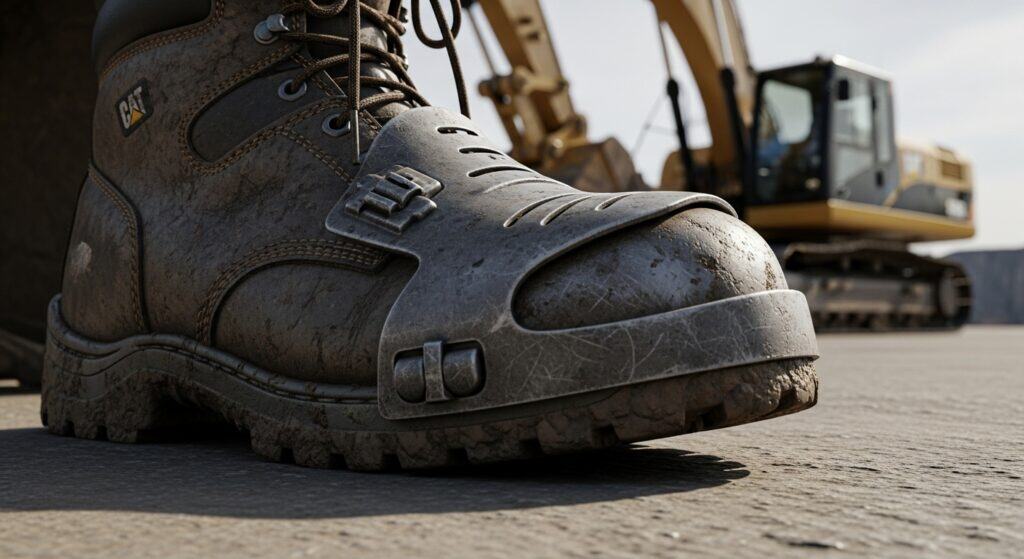
metatarsal guard boots
Here are the common questions operators ask about met guard boots:
Do I really need a met guard if I already have a steel toe?
Yes, absolutely. A steel toe only protects your toes. It is designed to stop where the foot flexes. A met guard (MT/75) protects the 26 delicate bones in the top of your foot (the metatarsals) from crushing injuries, which pose a substantial risk for operators. A steel toe alone is only half the protection required.
Are met guard boots uncomfortable or hard to walk in?
They used to be. Old external guards were notorious for being stiff and clunky. However, modern internal guards and smart foams (like D3O® or XRD®) are incredibly flexible and comfortable. Even modern external hinged designs (like the Timberland PRO Endurance) are much better than old rigid flaps.
Will a met guard boot make it harder to operate pedals in a tight cab?
This is a great question. Internal met guards (like D3O® or XRD®) are the best choice for operators; since they are soft and flexible, you won’t even notice them when driving. External (hinged) guards are bulkier. While they flex, they can feel clunky in very tight cab spaces or during delicate footwork on multiple pedals.
What does the “ASTM MT/75” rating mean?
This is the official safety standard. The ASTM F2413 standard sets performance requirements for protective footwear. The MT/75 marking certifies that the metatarsal guard can withstand an impact of 75 foot-pounds without failing. Always look for this rating.
Can I just add a clip-on met guard to my current boots?
You can find “retro-fit” met guards that lace over your boots, but we do not recommend them. They are clumsy, snag on everything, and can shift out of place during an impact, offering less reliable protection than a boot with a fully integrated and certified guard.
Conclusion: Don’t Compromise on Foot Protection
For a heavy equipment operator, the job site is full of impact and crushing hazards that go far beyond what a simple steel toe can handle. Protecting the top of your foot with an ASTM-rated metatarsal guard isn’t optional; it’s essential for a long, healthy career.
Don’t just buy a tough boot; buy the right boot. Choose a model with an integrated met guard, a defined 90-degree heel for climbing, and the durability to handle your site. The days of clunky, stiff met guards are over, thanks to modern “smart foam” materials.
| Top Pick (Flexible) | Top Pick (Durable) | Top Pick (Pull-On) |
|---|---|---|
| Cat Excavator Superlite | Timberland PRO Endurance | Ariat WorkHog XT |
| Best for driving & agility. | Best for max protection & longevity. | Best for convenience & comfort. |
| Buy Now | Buy Now | Buy Now |
For a perfect blend of modern, flexible comfort and full protection, check out the Cat Excavator Superlite with D3O®. For uncompromised, traditional durability, the Timberland PRO Endurance Met Guard is a proven tank that will keep you safe for years to come.



